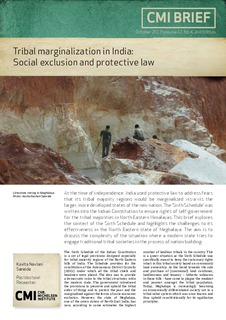| dc.contributor.author | Søreide, Kavita Navlani | |
| dc.date.accessioned | 2018-01-04T08:21:15Z | |
| dc.date.available | 2018-01-04T08:21:15Z | |
| dc.date.issued | 2013-01-01 | |
| dc.identifier | oai:www.cmi.no:5024 | |
| dc.identifier.citation | Bergen: Chr. Michelsen Institute (CMI Brief vol. 12 no. 4, 2nd edition) 4 p. | |
| dc.identifier.issn | 0809-6732 | |
| dc.identifier.uri | http://hdl.handle.net/11250/2475188 | |
| dc.description.abstract | At the time of independence, India used protective law to address fears that its tribal majority regions would be marginalized vis-a-vis the larger, more developed states of the new nation. The ‘Sixth Schedule’ was written into the Indian Constitution to ensure rights of self-government for the tribal majorities in North Eastern Himalayas. This brief explores the context of the Sixth Schedule and highlights the challenges to its effectiveness in the North Eastern state of Meghalaya. The aim is to discuss the complexity of the situation where a modern state tries to engage traditional tribal societies in the process of nation building. | |
| dc.language.iso | eng | |
| dc.publisher | Chr. Michelsen Institute | |
| dc.relation | CMI Brief | |
| dc.relation | 4 | |
| dc.relation.ispartof | CMI Brief | |
| dc.relation.ispartofseries | CMI Brief vol. 12 no. 4 | |
| dc.relation.uri | https://www.cmi.no/publications/5024-tribal-marginalization-in-india | |
| dc.subject | India | |
| dc.title | Tribal marginalization in India: Social exclusion and protective law | |
| dc.type | Report | |
